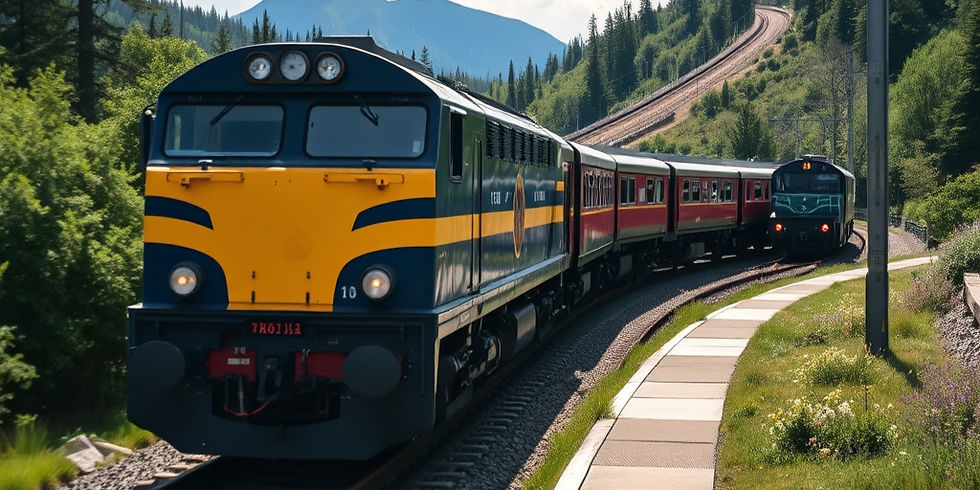HS2 and the Future of UK Freight: Opportunity or Oversight?
- Isabelle Miller

- Sep 22
- 3 min read

Written by: Isabelle Miller

Few UK infrastructure projects have triggered as much debate as High Speed 2. Originally pitched as a transformational upgrade to rail capacity and economic connectivity, HS2 has become a national question mark: is it a strategic investment in the country’s future, or an expensive diversion of funds from the rail services businesses rely on today?
Now that the northern leg has been cancelled, the conversation is shifting. The spotlight is moving from passenger travel to freight capacity — and to the role HS2 could still play in helping the UK move goods more efficiently.
Where Freight Fits Into the HS2 Equation
There is a common misconception that HS2 would carry freight. It wouldn’t. Its freight value lies in the space it could free up elsewhere.
High-speed passenger trains would move to HS2
That would release slots on the West Coast Main Line
Those freed-up paths could then be allocated to freight
In theory, this could mean up to 40% more rail freight capacity on existing routes — reducing pressure on motorways and cutting emissions from HGVs. In practice, it depends on future scheduling policy and political will.
Cost, Capacity and Contention
Issue | Supporters Say | Critics Say |
Cost | Long-term infrastructure requires bold investment | The budget escalation weakens the business case |
Capacity | HS2 could unlock rail freight growth | Commuter services may get priority instead |
Environment | Modal shift from road to rail cuts emissions | Construction emissions offset benefits for years |
Levelling Up | Better north–south connections boost regional economies | Freight-specific upgrades may offer faster ROI |
This tension is what keeps HS2 in the spotlight — and why logistics groups continue to urge government to revisit freight planning before the opportunity closes.
The Wider Question: Is Rail Ready for Growth?
Even without HS2, UK freight demand is rising due to:
eCommerce growth
port traffic and inland logistics corridors
urban congestion and clean air policies
carbon-reduction commitments
Rail could absorb some of this growth — but only if the capacity is actually reserved for freight and operators are able to load and plan with far greater efficiency than today.
Why Track Space Isn’t Enough
Extra train paths alone don’t guarantee supply chain performance. To make rail freight commercially viable long-term, precision becomes essential: accurate loading, higher utilisation rates per wagon, and better route planning.
This is where technology bridges the gap between capacity on paper and capacity in reality.
Real-time dimensioning tools — like GPC’s 3D measurement software — give operators the exact dimensions of pallets, parcels and irregular freight before loading. The result is:
Smarter wagon utilisation
Fewer “air miles” inside containers
Better network planning across multimodal transport
Lower emissions per tonne moved
If HS2 sets the stage, technology ensures the space is not wasted.
A Strategic Crossroads for UK Logistics
The future of HS2’s northern connection remains uncertain. But the conversation now goes beyond politics — it sits at the intersection of freight growth, network congestion, and technology modernisation.
Even if HS2 is scaled back or re-scoped, the pressure to expand rail freight capacity won’t disappear. Operators, councils and supply chain leaders will still need data-led tools to make every cubic metre count.
✅ Frequently Asked Questions (FAQs)
1. Can HS2 carry freight directly?
No. HS2 is a passenger-only railway. The freight benefit comes indirectly by freeing capacity on existing main lines.
2. How would HS2 help UK freight if it doesn’t carry goods itself?
By moving fast passenger trains onto HS2, traditional lines like the West Coast Main Line would have more available slots for freight services.
3. Is HS2 essential for shifting freight from road to rail?
It’s one route to additional rail capacity, but not the only one. Some experts argue freight-dedicated corridors or regional upgrades could deliver more direct impact.
4. Why are logistics groups calling for HS2’s northern leg to be revived?
Because the north–south rail network is already near capacity. Without expansion, freight growth may stall, increasing reliance on road haulage.
5. Would technology still be needed even if HS2 expands rail capacity?
Yes. Extra track space only matters if freight is optimised. Precision tools like real-time dimensioning help maximise wagon space, reduce costs, and improve planning.





Comments